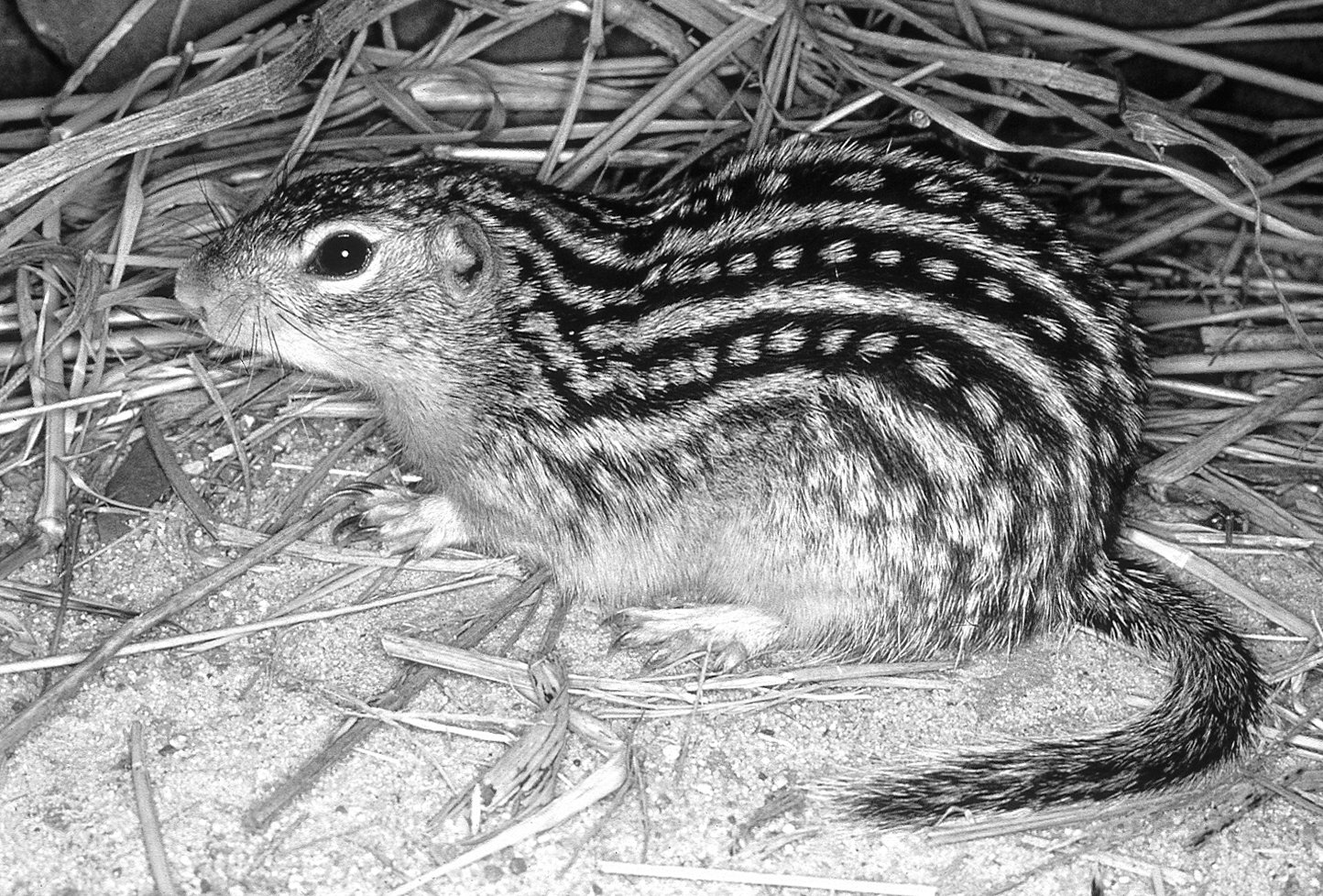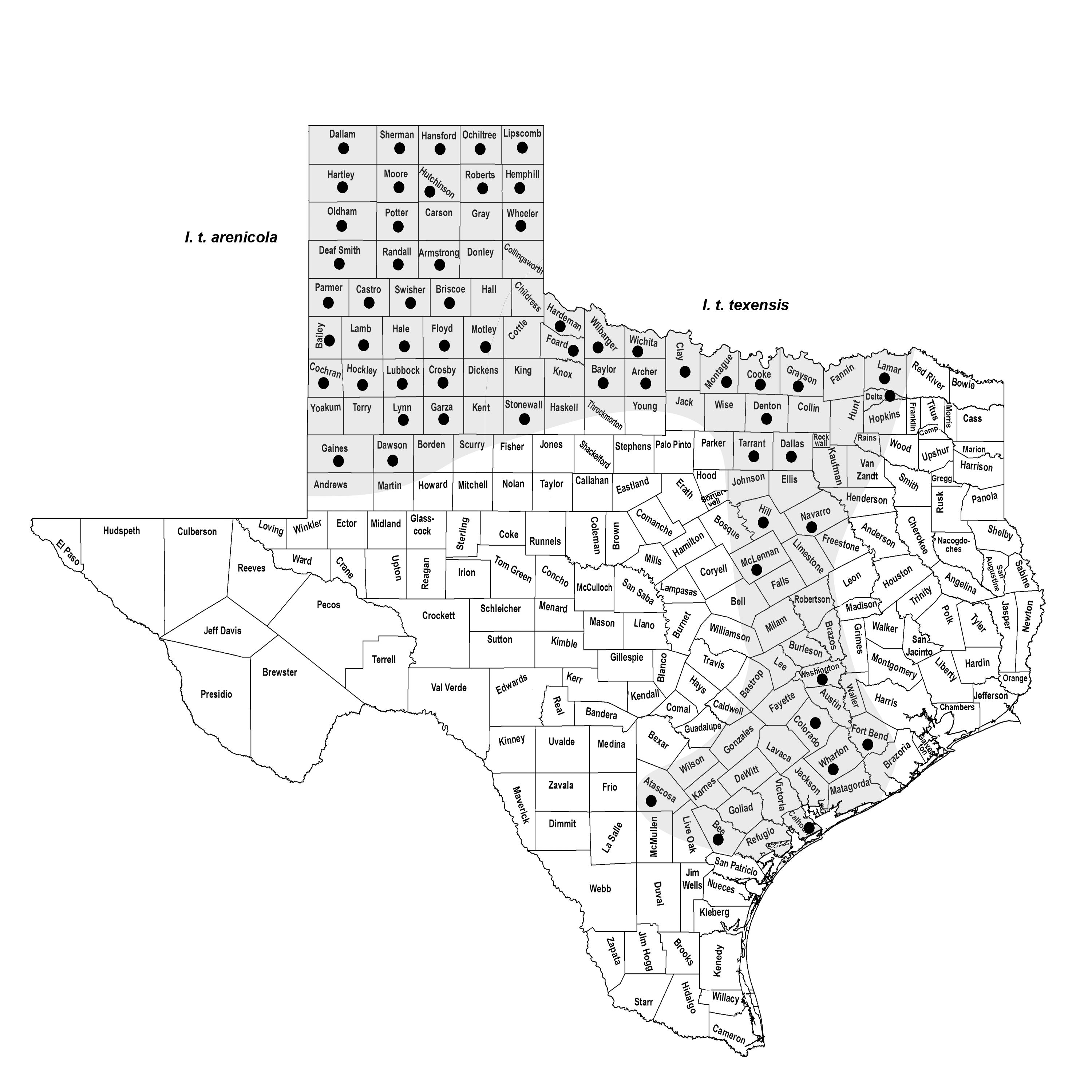THIRTEEN-LINED GROUND SQUIRREL
Ictidomys tridecemlineatus (Mitchill 1821)
Order Rodentia : Family Sciuridae
DESCRIPTION. A small ground squirrel (previously treated as Spermophilus tridecemlineatus; see "Remarks") with usually 13 alternating dark and light stripes, the dark ones containing a series of squarish or buffy spots, the light stripes occasionally broken into spots; dark dorsal stripes dark brown or black in color, the light stripes usually continuous and buffy white; underside of tail russet at base, shading to orange buff toward tip; lower sides cinnamon buff; belly pinkish buff; chin white; ears small. Dental formula: I 1/1, C 0/0, Pm 2/1, M 3/3 × 2 = 22. Averages for external measurements: total length, 285 mm; tail, 105 mm; hind foot, 40 mm. Weight of males 154 g (up to 212 g); of females, 160 g (to 220 g).

DISTRIBUTION. Known from northern Texas and in a corridor extending from Tarrant and Dallas counties in north-central Texas south to Atascosa, Bee, and Calhoun counties along the Gulf Coast.

SUBSPECIES. Ictidomys t. arenicola in the Panhandle and adjacent areas to the south and I. t. texensis elsewhere within the distribution in the state.
HABITS. These ground squirrels typically inhabit short-grass prairies, but they have invaded the tall-grass areas in Texas, where they live principally in pastures and along fencerows. They live in burrows in the ground from which radiate well-marked paths to the feeding areas. In tall grasses, the paths may become tunnels. In cultivated areas they seem to prefer fencerows and excavate their burrows near fence posts. Occasionally they use abandoned burrows of pocket gophers and prairie dogs. Their own burrows are about 5 cm in diameter, have two or three openings, descend to a depth of 10–115 cm, and may be >7 m in length.
These ground squirrels are strictly diurnal, but their annual cycle of activity includes a very long period of hibernation. In Texas, studies conducted by Howard McCarley (Austin College) in 1970 revealed that the period of hibernation lasts about 240 days. Adults enter hibernation in July and young of the year in August or September. They emerge from the middle of February to the first of March in the Texas Panhandle. In southern Texas they have been observed aboveground as late as 27 October and as early as January.
Their major food is green grasses and herbs in early spring, but seeds, flower heads, and insects become important to their diet as the season advances. Often more than half of the stomach contents consists of insects, including grasshoppers, crickets, caterpillars, beetles, ants, and insect eggs. They also eat mice and have been reported capturing and eating small chickens. Quantities of dry seeds stored in underground caches probably serve to carry the squirrels through the period of scarcity shortly after they emerge in the spring.
Mating activities begin about 2 weeks after squirrels emerge from hibernation. The males are sexually active for only 2–3 months, which of necessity restricts the length of the breeding season. Normally only one litter is produced annually, but one study found about 25% of the females observed in a marked population produced two litters. The gestation period is 27–28 days. The young vary in number from 2 to 13; yearling females produce the smallest litters. The young are blind, hairless, and toothless at birth and weigh 3–4 g each. By the 8th day they are dark dorsally; on the 12th the stripes begin to appear and hair sparsely covers the back; on the 26th day their eyes begin to open. Weaning takes place shortly after the eyes open, and at 6 weeks the young are entirely independent. They mature sexually at about 9 or 10 months of age.
Where concentrated in pastures and farming areas these squirrels may cause serious loss of forage and crops, but their intake of insects partly offsets any damage to vegetation. On rangelands they usually do little damage.
POPULATION STATUS. Common. The thirteen-lined ground squirrel is a widely occurring and common squirrel throughout the Texas Panhandle, but the populations from the central part of the state have declined dramatically as a result of the degradation of grassland habitat.
CONSERVATION STATUS. The IUCN recognizes the thirteen-lined ground squirrel as Spermophilus tridecemlineatus and lists it as a species of least concern. It does not appear on the federal or state lists of concerned species. Populations in the central region of the state need to be monitored carefully. No specimens have been reported from the southern portion of the range of I. t. texensis in the last several years.
REMARKS. Formerly included as Spermophilus tridecemlineatus, a 2009 taxonomic revision by Chris Helgen and colleagues (Smithsonian Institution)
necessitated placement of the thirteen-lined ground squirrel into the genus Ictidomys.
In 2013, Fred Stangl (Midwestern State University), Cody Thompson, and RDB demonstrated
that the thirteen-lined ground squirrel hybridizes with I. parvidens along their parapatric distribution (Hobbs, New Mexico, to near Wichita Falls, Texas).
Ictidomys tridecemlineatus reaches the limit of its geographic distribution in broad contact with the Rio Grande
ground squirrel on the southern Llano Estacado. Ictidomys tridecemlineatus is a species of the Great Plains, whereas I. parvidens is a species of desert grasslands, but competitive interaction has not been documented
other than the supposed areas of hybridization. Hybridization may affect long-term
genetic purity of populations in north-central Texas; consequently, these latter populations
need to be monitored carefully.
From The Mammals of Texas, Seventh Edition by David J. Schmidly and Robert D. Bradley, copyright © 1994, 2004, 2016. Courtesy of the University of Texas Press.
Natural Science Research Laboratory
-
Address
Museum of Texas Tech University, 3301 4th street, Lubbock, TX 79409 -
Phone
806.742.2486 -
Email
nsrl.museum@ttu.edu

